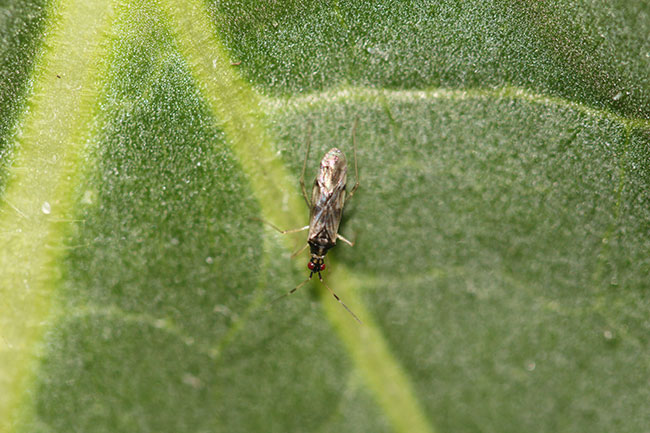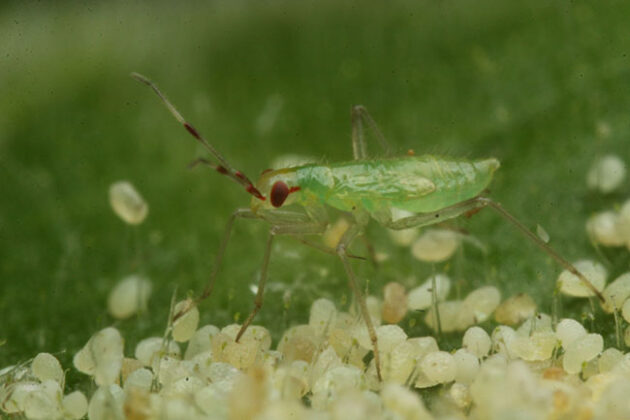
Features
Biocontrols
Research
New agents, new level of pest control
A look at how Canada is leading the globe in the development of biological control agents for greenhouse insect pests
September 6, 2024 By Treena Hein
 Canadian researchers are currently exploring how Dicyphis Discrepens (female, pictured above) may be used for biocontrol. Source: Carly Demers, AAFC
Canadian researchers are currently exploring how Dicyphis Discrepens (female, pictured above) may be used for biocontrol. Source: Carly Demers, AAFC In response to the needs of greenhouse operators across Canada, the development of new biocontrol agents for pest control continues, building on strong past success. Indeed, “Canada is a world leader in biocontrol,” says Dr. Rose Buitenhuis, director of the Biological Crop Protection program at Vineland Research and Innovation Centre (Vineland) in Ontario. “We still have a lot to learn but we can showcase to the world what we do.”
Because of this success, Buitenhuis notes that the adoption of biocontrol agents is very close to 100 per cent in the Canadian greenhouse sector across both vegetables/fruit and ornamentals. “Not everyone has an easy time of it and it must often be integrated with other control methods,” she explains, “but in general it’s going very well. The agents don’t always do what you like them to do, unless you keep them healthy and happy. One way to do this is through improved release methods.”
One example is a new release sachet for Phytoeiulus persimilis mites, which eat spider mites. Previously, this predator had to be released every week. Buitenhuis says BioBee has developed a sachet with a diet that sustains P. persimilis so that these mites can complete their life cycle and new generations are produced, entering the greenhouse over the course of several weeks.
But Buitenhuis stresses that “always, there are new pests that emerge.
“Plant materials are shipped all over the world, and there are strict regulations to try and prevent the transport of pests with these materials, but it’s very difficult to detect small bugs or eggs,” she said.
An example of a pest that has emerged recently is a new thrips species, Thrips parvispinus, which has been found in tropical ornamentals in Canada. It has also negatively affected greenhouse pepper production in Europe and is therefore also a potential problem in Canadian vegetable greenhouse crops.
“We have formed a Canadian research team to be prepared,” says Buitenhuis. “This team includes Dr. Rose Labbé at Agriculture & Agri-food Canada (AAFC), and at the Ontario Ministry of Agriculture, Food & Rural Affairs, Dr. Sarah Jandricic and Cara McCreary. We don’t want to go back to spraying, as that may wipe out existing biocontrol programs. So, we are investigating the behaviour of these thrips, which locations on the plant they attack and how they are different from Western Flower Thrips, and we’ll see if the available biocontrol agents work well to control this species.”
New agents
In January 2024, Jandricic, Heidi Wollaeger at Michigan State University Extension and Raymond Cloyd at Kansas State University, published a free 16-page catalogue of Commercially-Available Biological Control Agents for Greenhouse Insect and Mite Pests.
One of these is Anystis baccarum or ‘crazee mite’, a native-to-Canada predator of many insects that was identified and developed by Taro Saito in Buitenhuis’ laboratory, and subsequently commercialized by a partner of Vineland’s, Applied Bio-nomics of B.C.. (Note that while the main approach to biocontrol in the past has focused on importing a pest’s natural enemies from their source location, recently the importation of exotic generalist predators and parasitoids has been restricted due to their non-target effects.) The Anystis mite is a generalist predator that will eat whiteflies, aphids, mealybugs, thrips and more. Buitenhuis explains that because it’s such an extreme generalist, it is recommended to strengthen biocontrol programs when combined with other, more specialist predators.
Harnessing technology
To speed up testing of new potential native biocontrol agents, Buitenhuis and her colleagues are working to integrate cutting-edge techniques where possible. These include automated computer vision counting systems that can be used, for example, for counting how many pests are present on a plant in an experiment.
Buitenhuis adds that “ultimately, all this data can be used to develop models to predict what will occur in different scenarios. We are also looking into molecular techniques to detect the presence of an organism based on the traces of DNA left behind. This can be used, for example, to see what an insect has eaten in terms of plant or prey material.”

nother close-up of the Dicyphus hesperus, an emerging beneficial that scientists say could become useful in controlling tomato pinworms (Phthorimaea absoluta).Source: Carly Demers, AAFC
Breeding better agents for pest control
Some biocontrol agents eat both plant material and pests. If specific agents that eat a target pest can be bred to prefer the pest over plants, that would be an excellent outcome. So, in addition to Canadian biocontrol scientists leading the world in identifying existing predators, some are also breeding agents to be more effective.
Dr. Francois Dumont is one of these scientists, based at Centre de recherche agroalimentaire de Mirabel (CRAM) in Québec, an institute that offers research and technology transfer services in horticulture and agri-food to help the private sector succeed.
“My research on Dicyphus Hesperus (a type of insect known as a mirid) was completed two years ago and we recently published our first article,” Dumont notes. “A second article will follow later this year. We are currently conducting similar research in collaboration with Dr. Labbé.”
The species studied are D. famelicus, D. discrepans, Nabis americoferus and Macrolophus teunicornis. These insects may be used some day to control a globally-invasive potential greenhouse pest in Canada, Phthorimaea absoluta. This moth species, known as tomato leaf miner, tomato pinworm and South American tomato moth, is well known as a serious pest of tomato crops in Europe, Africa, western Asia and South and Central America.”
Labbé, a research scientist in greenhouse entomology at the AAFC Science and Technology Branch in Harrow, Ont., explains that they continue to work with these native biocontrol agents through an Agri-Science Cluster project with the Fruit and Vegetable Growers of Canada, and in collaboration with Biobest, a biocontrol company based in Belgium with operations in Canada that offers products under many brands.
“As Francois has indicated, we [including PhD study Carly Demers] are taking on a breeding approach to genetically select and optimize the predatory performance of these agents on greenhouse crops,” she says.
“We also hope to study their fundamental biology including their dispersion behaviour, bionomics, predatory capacity on different crop pests, and interaction with other biocontrol agents.”
So far, they have observed that N. americoferus reproduces well and rapidly on tomato as a host plant. Adult females significantly outlive males, but D. discrepans and D. famelicus live considerably longer and lay more eggs during their lifetimes. Predation of moth species was observed to be greater overall for N. americoferus compared to the mirids, but it is quite possible that mirids could perform better when offered other types of prey such as whiteflies or aphids, and/or companion host plants (mullein or rosaceous).
Current lab and greenhouse studies focus on defining mirid rates of consumption for many other prey types (whiteflies, thrips, spider mites, aphids) in comparison to D. Hesperus. The team also wants to define the role of companion plants for mirid predator establishment and find out if predators are nocturnal in terms of activity and is this affects where they are during the day/night. They also want to determine how predator behaviour or volatility affect dispersal after release and biocontrol ability (D. disrepans, for example, is a subdued insect while D. famelicus and D. Hesperus are ‘very flighty’).
How breeding works
To selection process, Dumont explains, is not complex. “In general, we test the individuals of each generation and retain those who meet certain behavioral criteria,” he says. “Another possibility is to create ‘isofemale’ lines, based on a single female, and select lines offering the desired characteristics.”
The number of selection generations depends on the intensity of selection (the number of individuals selected from the entire population of each line). The time required to complete selection also depends on each species. “Some develop rapidly, while others take several months to complete their life cycle,” says Dumont. Regarding factors that might speed up selection and testing progress, Dumont reports that there aren’t any. “It takes time,” he says.
The main challenges with breeding better biocontrol agents, he explains, are that “we need to achieve a balance in the intensity of selection. Over-intensive selection increases the chances of gene drift (each generation being based on too few individuals), while less-intensive selection requires more time and resources to carry out.”
Read more on biocontrols here.
Print this page



